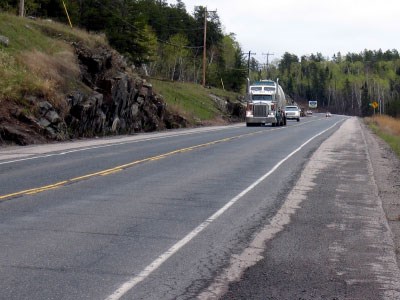A provincial plan to access the Ring of Fire may be lacking, but for almost three years the Ministry of Transportation (MTO) has been quietly working on a major pan-northern planning exercise to support future regional economic development.
Known as the Northern Ontario Multimodal Transportation Strategy, the multi-year study is directly tied into the Liberal government’s implementation of the Northern Growth Plan.
“It’s definitely a first for the MTO in Northern Ontario,” said Tija Dirks, the ministry’s director of transportation planning, of the comprehensive process which began in 2011.
“The scope of the issues that we’re looking at is much broader. We’re truly looking at the transportation system and not just the highway network.”
The MTO hired consultants to interview more than 100 people from the mining, forestry, manufacturing, agriculture and tourism sectors, together with input from First Nation, Métis and municipal leadership.
At the same time, travel surveys were done at border points, truck inspection stations and highway rest stops.
The intent of the exercise is for the MTO to get detailed look at how the region’s supply chain works, identify the movement of goods and people across Northern Ontario, and forecast what future traffic patterns and volumes will look like.
Interviewees from all industry sectors recommended Highway 11 be four-laned between North Bay and Hearst, and between Thunder Bay and the Rainy River district, or at least more passing lanes added. Others want four lanes on Highway 17 between Sudbury and Sault Ste. Marie.
They said some key winter roads should be replaced with year-round permanent roads to reach remote Aboriginal communities and forestry management units.
There were calls for airport infrastructure upgrades, better rail and bus service, a port expansion in Sault Ste. Marie, and stable government funding mechanisms to support it all.
Those surveyed also lamented the lack of road and rail access to the Ring of Fire, inner city congestion in Sudbury, the absence of major railway intermodal facilities, and the need for better highway rest stops and tourism signage.
About 60 of those people interviewed attended a special workshop in Sudbury, Dec. 4, where all the data gathered to date was presented.
“If this first phase was about gathering information,” said Dirks, “this next phase is, what do we do about it?”
The next steps will be to identify any gaps or deficiencies in the north’s transportation network and put together a to-do list to determine priorities for an actual strategy.
Dirks said the conversion with stakeholders throughout this process will continue through various means such as technical and working groups.
Most of the work to devise the transportation strategy will be largely complete by the winter of 2015-2016 and implementation would need final support from the premier and cabinet.
Whether a spring election and a new government at Queen’s Park would scuttle the strategy in midstream remains to be seen.
“The work would still on go on unless we were told to halt it,” said Dirks. “That’s always the prerogative of a new government, but the principles and the need to look at the transportation system remains. We haven’t heard any dissenters on the need for this work from any side.”




